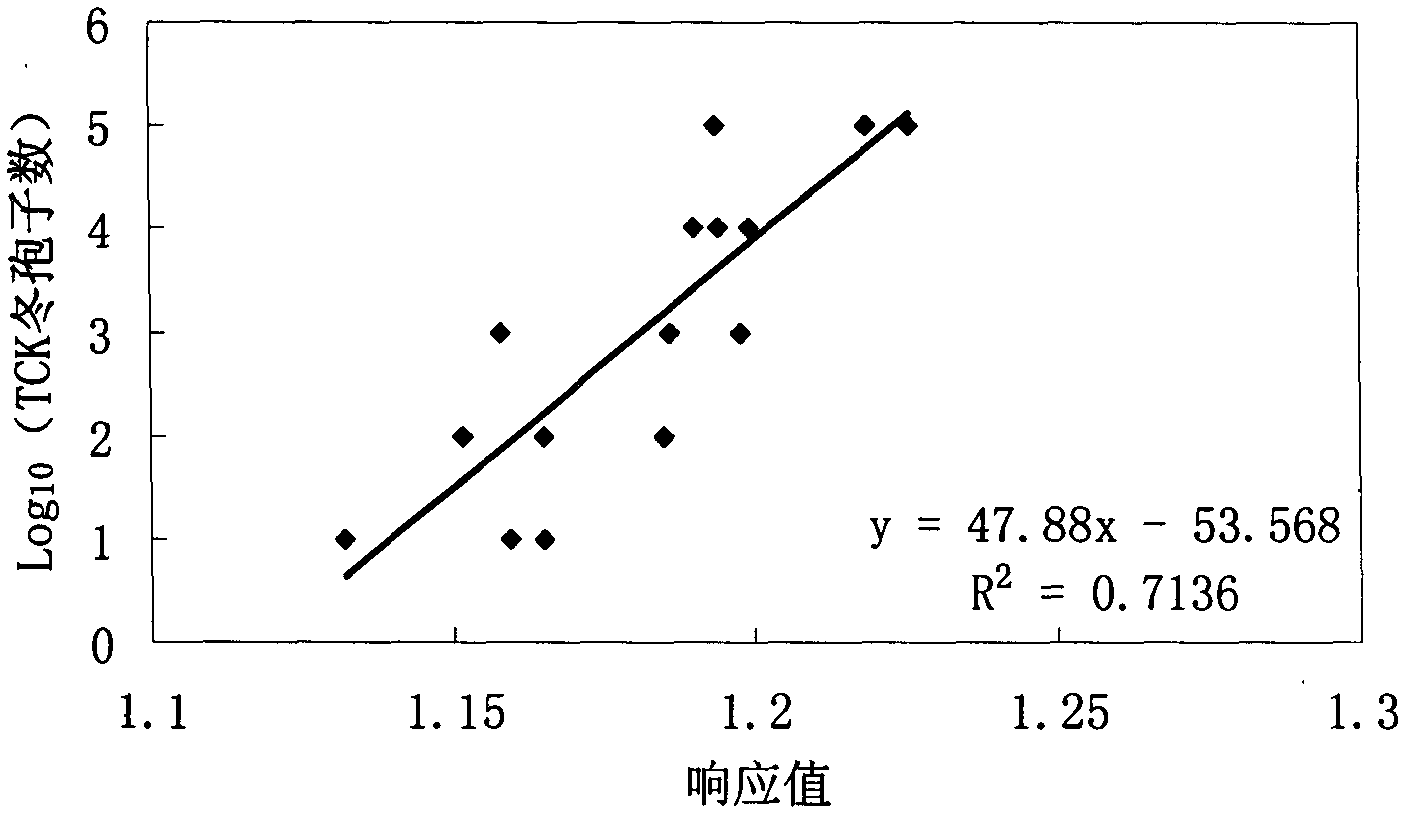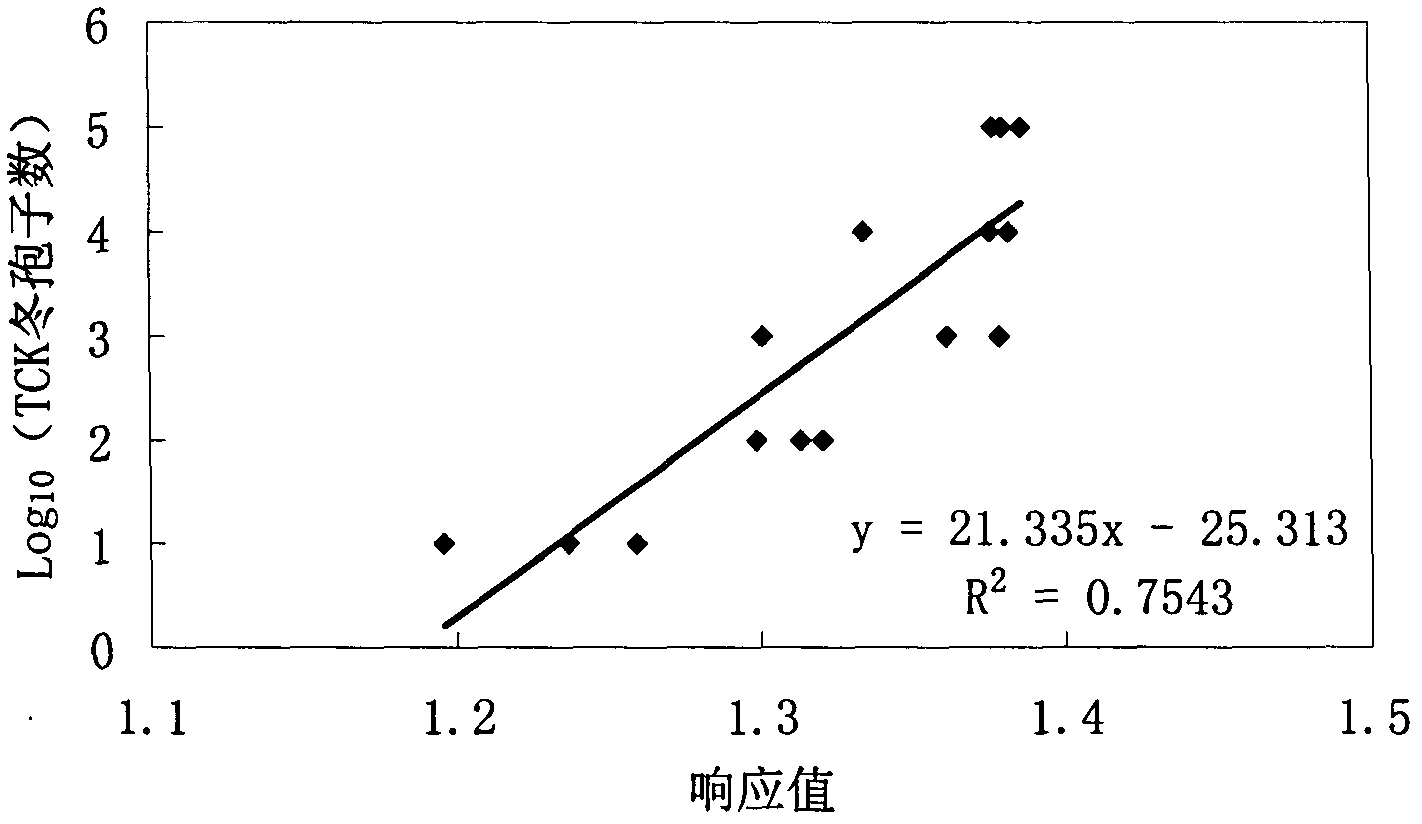Method for rapidly and quantitatively detecting Tilletia controversa Kuhn in wheat based on electronic nose
A quantitative detection method, the technology of dwarf smut, applied in measuring devices, material analysis through electromagnetic means, instruments, etc., can solve the problems of quantitative detection of unseen wheat, and meet the needs and sensitivity of plant quarantine and disease monitoring High and cost-saving effect
- Summary
- Abstract
- Description
- Claims
- Application Information
AI Technical Summary
Problems solved by technology
Method used
Image
Examples
Embodiment 1
[0028] Example 1: Establishment of a relationship model between TCK teliospore content in unfumigated wheat and the response value of the electronic nose sensor
[0029] 1) Preparation of samples with different TCK teliospore contents in unfumigated wheat
[0030] Weigh 50g of unfumigated wheat seeds and put them into a 100ml Erlenmeyer flask, and use a hemocytometer to make the teliospore concentration of TCK under a microscope into 10 8 ml -1 And after gradient dilution, add in the triangular flask that wheat seed is housed, make the teliospore content in every 50g seed respectively 10 5 、10 4 、10 3 、10 2 、10 1 、10 0 and contrast. Seal with a double layer of plastic wrap.
[0031] 2) Electronic nose measurement method
[0032] Use direct headspace aspiration. That is, the injection needle is directly inserted into a Erlenmeyer flask sealed with double-layer plastic wrap filled with wheat, and the electronic nose is used for determination. The electronic nose uses ...
Embodiment 2
[0039] Example 2: Establishment of relationship model between TCK teliospore content in wheat after fumigation and electronic nose sensor response value
[0040] 1) Preparation of samples with different TCK teliospore contents in wheat after fumigation
[0041] Weigh 50g of fumigated wheat seeds and put them into a 100ml Erlenmeyer flask, and use a hemocytometer to make the teliospore concentration of TCK under a microscope into 10 8 ml -1 And after gradient dilution, add in the triangular flask that wheat seed is housed, make the teliospore content in every 50g seed respectively 10 5 、10 4 、10 3 、10 2 、10 1 and contrast. Seal with a double layer of plastic wrap.
[0042] 2) 2) Electronic nose measurement method
[0043] Use direct headspace aspiration. That is, the injection needle is directly inserted into a Erlenmeyer flask sealed with double-layer plastic wrap filled with wheat, and the electronic nose is used for determination. The electronic nose uses the PEN3 ...
Embodiment 3
[0050] Example 3: Quantitative detection of TCK teliospore content in unfumigated wheat
[0051] 1) Sample preparation for quantitative detection of TCK content in wheat
[0052] Weigh 50g of the wheat sample to be tested and put it into the Erlenmeyer flask, and seal it with double-layer plastic wrap.
[0053] 2) Electronic nose measurement method
[0054] Use direct headspace aspiration. That is, the injection needle is directly inserted into a Erlenmeyer flask sealed with double-layer plastic wrap filled with wheat, and the electronic nose is used for determination. The electronic nose uses the PEN3 electronic nose system produced by the German AIRSENSE company, which contains 10 different metal oxide sensors to form a sensor array.
[0055] 3) Measurement conditions
[0056] The sampling time is 1 second / group, the sensor self-cleaning time is 100 seconds, the sensor zeroing time is 10 seconds, the sample preparation time is 3 seconds, the sample flow rate is 300ml / min...
PUM
 Login to View More
Login to View More Abstract
Description
Claims
Application Information
 Login to View More
Login to View More - R&D
- Intellectual Property
- Life Sciences
- Materials
- Tech Scout
- Unparalleled Data Quality
- Higher Quality Content
- 60% Fewer Hallucinations
Browse by: Latest US Patents, China's latest patents, Technical Efficacy Thesaurus, Application Domain, Technology Topic, Popular Technical Reports.
© 2025 PatSnap. All rights reserved.Legal|Privacy policy|Modern Slavery Act Transparency Statement|Sitemap|About US| Contact US: help@patsnap.com


